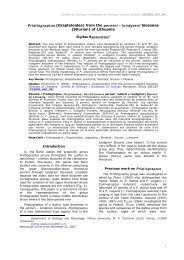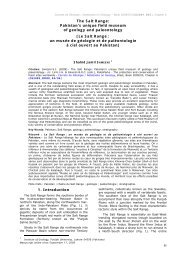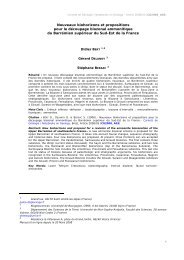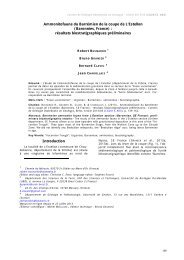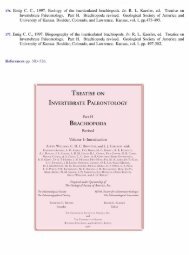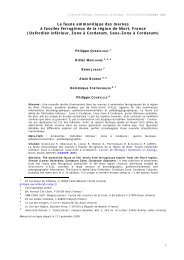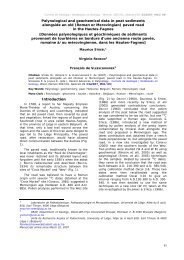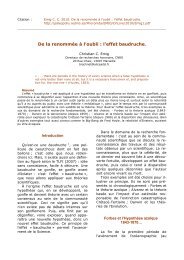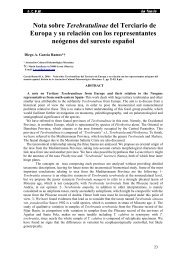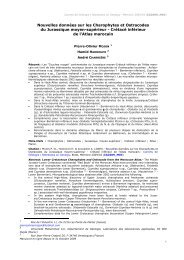Understanding linguloid brachiopods - HAL
Understanding linguloid brachiopods - HAL
Understanding linguloid brachiopods - HAL
- No tags were found...
You also want an ePaper? Increase the reach of your titles
YUMPU automatically turns print PDFs into web optimized ePapers that Google loves.
Carnets de Géologie / Notebooks on Geology - Article 2003/06 (CG2003_A06_LEP-LEH)<strong>Understanding</strong> <strong>linguloid</strong> <strong>brachiopods</strong>: Obolus and Ungula as examplesLeonid E. P OPOV 1 andLars E. H OLMER2Abstract: EMIG (2002) re-examined the taxonomy of the genus Obolus EICHWALD from the MiddleCambrian - earliest Ordovician of the East Baltic region as part of a proposal for a wholesale revisionof the principles of <strong>linguloid</strong> systematics. He contended that previous taxonomic studies on Obolusand related forms were carried out erroneously using characters that have no taxonomic value. EMIG´sproposed revision is based mainly on the limited morphological diversity between fossil and Recenttaxa within a single <strong>linguloid</strong> Family, the Lingulidae. However, the present study demonstrates thetaxonomic validity of the diagnostic characters used for classification within the mostly extinctfamilies of the Superfamily Linguloidea, for they exhibit far more variation in morphology. This studyalso shows that EMIG has provided no satisfactory basis for his radical changes and revisions to theexisting widely accepted taxonomy of the Cambrian to earliest Ordovician Obolidae of the East Baltic.Obolus EICHWALD and Ungula PANDER are shown to constitute distinctive and discrete generacomprising the species Obolus apollinis EICHWALD, O. ruchini KHAZANOVITCH et POPOV, O. transversus(PANDER), Ungula ingrica (EICHWALD), U. inornata (MICKWITZ), and U. convexa PANDER.Key Words: Taxonomy; Obolus; Ungula; Brachiopoda; Cambrian; Ordovician; East BalticCitation: POPOV L.E., HOLMER L.E. (2003).- <strong>Understanding</strong> <strong>linguloid</strong> <strong>brachiopods</strong>: Obolus and Ungula asexamples.- Carnets de Géologie / Notebooks on Geology, Maintenon, Article 2003/06(CG2003_A06_LEP-LEH)Résumé : Comprendre les brachiopodes <strong>linguloid</strong>es : Obulus et Ungula comme exemples.- EMIG(2002) a revu la taxonomie du genre Obolus EICHWALD du Cambrien moyen - Ordovician basal desrégions baltes orientales dans le cadre d'un projet de révision de l'ensemble des critères de lasystématique des <strong>linguloid</strong>es. Il a suggéré que les études taxonomiques antérieures sur Obolus etles formes apparentées sont fondées à tort sur des caractères dépourvus de toute valeurtaxonomique. La révision proposées par EMIG s'appuie principalement sur les faibles variationsmorphologiques observées entre taxons fossiles et récents au sein d'une seule famille de <strong>linguloid</strong>e,les Lingulidae. Notre article s'attache à démontrer la validité taxonomique des critères diagnostiquesutilisés dans la classification au sein des familles, pour la plupart éteintes, de la Superfamille desLinguloidea, car ils présentent une bien plus grande diversité morphologique. Cette étude montreaussi que EMIG n'a pas proposé une base satisfaisante pour étayer les changements et révisionsradicaux qu'il souhaite apporter à la taxonomie, en vigueur et largement acceptée, des Obolidae desséries du Cambrien à l'Ordovician basal des régions baltes orientales. Obolus EICHWALD et UngulaPANDER sont considérés comme des genres distincts comprenant les espèces Obolus apollinisEICHWALD, O. ruchini KHAZANOVITCH et POPOV, O. transversus (PANDER), Ungula ingrica (EICHWALD), U.inornata (MICKWITZ) et U. convexa PANDER.Mots-Clefs : Taxinomie ; Obolus ; Ungula ; Brachiopoda ; Cambrien ; Ordovician ; Baltique orientaleРезюме: Л.Е. Попов, Л.Е. Холмер. ВОПРОСЫ СИСТЕМАТИКИ БЕЗЗЗАМКОВЫХ БРАХИОПД НАПРИМЕРЕ РОДОВ Obolus И Ungula.- Эмиг (2002) недавно пересмотрел таксономию рода ObolusEICHWALD из среднего кембрия - раннего ордовика Восточной Прибалтики, как частьпредполагаемой широкой ревизии основ систематики лингулид. Он настаивает на том чтопредыдущие исследования Obolus и близких к нему родов, опубликованные в работахГорянского, Попова, Пуура и Холмера, были по преимуществу основаны на анализе признаковлишенных таксономического значения. Критика Эмига основывается главным образом на егопредставлениях о морфологическом разнообразии в пределах единственного нынесуществующего семейства однако, настоящее исследование демонстрирует значительно большееразнообразие таксономически значимых морфологических признаков строения раковины удревних, палеозойских лингулид, объединяемых в составе надсемейства которое в значительнойстепени выходит за рамки, известные среди мезо-кайназойских представителей этой группы. Неттакже оснований для радикальных изменений существующей таксономии кембрийских ираннеордовикских оболид из Восточной Прибалтики. Obolus EICHWALD и Ungula PANDERпредставляют отличные и хорошо морфологически диагносцируемые роды семейства Obolidae.Они включают следующие разновидности: Obolus apollinis EICHWALD, O. ruchini KHAZANOVITCH etPOPOV, O. transversus (PANDER), Ungula ingrica (EICHWALD), U. inornata (MICKWITZ) и U. convexaPANDER.Ключевые слова: Таксономия, Obolus, Ungula, Брахиоподы, Кембрий, Ордовик, Прибалтика1Department of Geology, National Museum of Wales, Cathays Park, Cardiff CF10 3NP, Wales (U.K.)Leonid.Popov@nmgw.ac.uk2Institute of Earth Sciences, Palaeobiology, Uppsala University, SE-752 36 Uppsala (Sweden)Lars.Holmer@pal.uu.seManuscript online since September 12, 20031
Carnets de Géologie / Notebooks on Geology - Article 2003/06 (CG2003_A06_LEP-LEH)IntroductionThe <strong>linguloid</strong> brachiopod Obolus has been thesubject of numerous controversies since it wasfirst established by EICHWALD in 1829 (seesummaries by MICKWITZ, 1896; GORJANSKY, 1969;POPOV et alii, 1989). Recently, EMIG (2002) usedObolus as an example in a proposal for revising<strong>linguloid</strong> taxonomy, by limiting the "valid"(sensu EMIG, 2002) taxonomic characters to avery restricted number of features (see alsoEMIG, 1982; 1983), declaring that previousstudies of Obolus and related forms (e.g.GORJANSKY, 1969; POPOV et alii, 1989; HOLMERand POPOV, 2000; PUURA, 1996) are based mainlyon characters that have "no taxonomic value"(sensu EMIG, 2002). The proposal by EMIG (2002)is based almost entirely on his experience withfossil and Recent members of a single <strong>linguloid</strong>Family, the Lingulidae (e.g. EMIG, 1982; 1983;BIERNAT and EMIG, 1993). Here we argue that thelimited morphological diversity of the taxa foundwithin this family is not a useful basis forworking out the taxonomy of the 10 otherextinct families now recognized within the veryvariable and diverse Superfamily Linguloidea(HOLMER and POPOV, 2000).The present is obviously the key to the past,but we should not let the present restrict ourunderstanding of the past; the fact is that therehas been a drastic loss of diversity within manygroups such as the Recent <strong>linguloid</strong> <strong>brachiopods</strong>.Furthermore, some of the most important newcontributions to the understanding of thetaxonomy and phylogeny of the SuperfamilyLinguloidea and related Lingulate taxa comefrom detailed studies of the shell structure andmicro-ornamentation (Recent and fossil), whichare proving to be the most valid characters fortaxonomic purposes (e.g. CUSACK et alii, 1999;HOLMER, 1989, 2001; WILLIAMS, 2003; WILLIAMSand CUSACK, 1999; WILLIAMS et alii, 1994, 1997,2000).EMIG (2002) does not take into account thesenew developments in the understanding of theultrastructure of the Lingulate shell and itsphylogenetic importance. When dealing withfossil taxa it is also essential to understandsomething of the geological setting in which thetaxa are found, and in particular thestratigraphic context must be considered. EMIG(2002) does not so the geological associations ofObolus and Ungula are summarised below.Obolus and Ungula in the East Baltic- a brief reviewThe type species of Obolus, O. apollinisEICHWALD, is from a well known locality on theLuga River near the town of Kingisepp (formerlyJamburg, St. Petersburg or "Leningrad" District,Russia), where it occurs in several exposures ofthe so-called "Obolus sands" in the lower TosnaFormation (uppermost Upper Cambrian:Cordylodus proavus - lower C. lindstromiconodont biozones). Fortunately, the typematerial of Obolus apollinis EICHWALD, as well asthat of another obolid species described byEICHWALD (1829) as Obolus (= Ungula) ingrica, ispreserved in the Department of HistoricalGeology of St. Petersburg State University(contrary to the statement by EMIG, 2002, p. 8),and POPOV and KHAZANOVITCH (in POPOV et alii,1989) selected lectotypes for both species.MICKWITZ (1896) monographed the <strong>brachiopods</strong>from the "Obolus sands" and erroneouslysynonymised these two species withoutchecking the type material; this practice wasalso adopted by most subsequent researchers(e.g. WALCOTT, 1912; BULMAN, 1939; ROWELL,1965, etc.) until GORJANSKY (1969) demonstratedthe validity of Obolus apollinis and Ungulaingrica as discrete entities.The monographic study of the <strong>brachiopods</strong>from the "Obolus sands" by POPOV andKHAZANOVITCH (in POPOV et alii, 1989) was basedon a total of more than 10,000 specimens (frommore than 100 localities including core material)with carefully measured biometric data thatfurther demonstrated that Obolus apollinis andUngula ingrica are disparate in both space andtime. At the few localities where Obolus apollinisand Ungula ingrica occur together, the valves ofthe former species show clear signs of redeposition(POPOV et alii, 1989).POPOV and KHAZANOVITCH (in POPOV et alii,1989) resolved the long-standing problemsconnected with several species of Unguladescribed by PANDER (1830) from the southernoutskirts of St Petersburg. The original PANDERcollection was lost possibly at the end of thenineteenth century (for details see JAANUSSONand BASSETT, 1993). However, preciseinformation on the geology of the type area(provided by PANDER) made it possible todetermine that the type locality of these speciesis on the Izhora River (near the abandonedvillage of Samsonovka). It is clear that PANDER'sspecies are distinct and valid (see GORJANSKY,1969; POPOV et alii, 1989, for details). Of these,Obolus transversus (PANDER, 1830), occurs in theRebrovo Member of the Sablinka Formation(uppermost Middle Cambrian, Fig. 2), whereasUngula convexa PANDER, 1830, is from the uppermember of the Ladoga Formation (UpperCambrian), where it occurs in association withmoderately diverse acritarch and conodontassemblages that date the beds as being withinthe interval of the Leptoplastus and lowerParabolina spinulosa Biozones of theScandinavian trilobite standard (MARTINSSON,1974).2
Carnets de Géologie / Notebooks on Geology - Article 2003/06 (CG2003_A06_LEP-LEH)Figure 1: Examples of variations in shell outline and relative valve convexity in selected Palaeozoic lingulidegenera.3
Carnets de Géologie / Notebooks on Geology - Article 2003/06 (CG2003_A06_LEP-LEH)Figure 2: Columnar sections through the Cambrian-Ordovician boundary beds in the East Baltic at the Volkhov andIzhora rivers (see POPOV et alii, 1989, for details) showing of distribution of discussed relevant species.Ungula convexa is the type of Ungula PANDER,1830, which as demonstrated by POPOV andKHAZANOVITCH (in POPOV et alii, 1989) is differentfrom Obolus (see further below).Species of Obolus are generally associatedwith the Skolithos ichnofacies and show apreference for well-aerated shallow marineenvironments, possibly, with low primarybiological productivity. Its relatively thin shellswere not resistant to transportation and redepositionand it is likely that coquinas with thebest preserved shells from the Kingiseppquarry, Luga, Lava and Suma rivers weredeposited in beach ridges above average sealevelduring strong storm events (ARTYUSHKOV etalii, 2000).Unlike Obolus, the species of Ungula do notco-occur with Skolithos ichnofacies, and theshells of Ungula are invariably enriched insulfides and are secondarily phosphatized, whichmay suggest fossilization in a dysaerobicenvironment. The host rock often contains thinlayers of black bituminous argillite. All thesefactors suggest that Ungula was adapted to lifein shallow waters, characterized by highprimary biological productivity, strong dailyfluctuations in the content of oxygen, andpossibly, periodical eutrophication. Thephosphatized shells of Ungula were resistant tore-deposition and they constitute a significantpart of the deposits that have been minedcommercially in North Estonia (POPOV et alii,1989).Obolus and Ungula are currently regarded asendemic Baltoscandian taxa, each representedby three successive species (Kaljo et alii, 1986;POPOV et alii, 1989). Obolus is represented bytwo successive Middle Cambrian species, Obolusruchini KHAZANOVITCH et POPOV, 1984 and Obolustransversus (PANDER, 1830) (Fig. 2). No speciesof Obolus occur in the lower and medial portionsof the Upper Cambrian, but Obolus apollinisEICHWALD then appears in the Cordylodusproavus Biozone and ranges into the lowerTremadoc Cordylodus angulatus Biozone. Incontrast, Ungula is confined entirely to theUpper Cambrian where it is represented byUngula inornata (MICKWITZ, 1896), Ungulaconvexa (PANDER, 1830) and Ungula ingrica(EICHWALD, 1829). The stratigraphical ranges of4
Carnets de Géologie / Notebooks on Geology - Article 2003/06 (CG2003_A06_LEP-LEH)the most important of these species areillustrated by two sections in the St Petersburgregion (Fig. 2; see POPOV et alii, 1989 for a fullaccount of the brachiopod biostratigraphy). Amore detailed summary in English of thelithostratigraphy of the Middle Cambrian toLower Ordovician deposits and associatedfaunas in the East Baltic is given by KALJO et alii(1986).Morphological diversity ofPalaeozoic Linguloidea versusMesozoic-Cenozoic LingulidaeAccording to EMIG (2002, p. 2) "the maintaxonomic criteria used to discriminate between<strong>linguloid</strong> taxa were established and figured byEMIG (1982, 1983) and BIERNAT and EMIG(1993)". He also noted (p. 3) that "externalfeatures as shape, size and dimension ratios ofthe valves have been demonstrated to have notaxonomic value" although at the same timemaking an exception for Lingula adamsi with itsdistinctive subrectangular shell outline. It isimportant to note that these statements arebased only Recent and Mesozoic-CenozoicLingulidae, which do not represent the totalmorphological diversity of the group (shellshapes, ornament, shell structure, characters ofpseudointerareas, etc.; Fig. 1). The post-Palaeozoic members of the Lingulidae, withtheir infaunal mode of life in near-shoreenvironments represent only a small fraction ofthe diversity of shell morphologies and lifestyles observed in <strong>linguloid</strong>s that lived inPalaeozoic times (BASSETT et alii, 1999; HOLMERand POPOV, 2000). It is not necessary to discussall aspects of variation in <strong>linguloid</strong> shellmorphologies in this paper, as it is treated in fullin the latest edition of the Treatise onInvertebrate Paleontology (WILLIAMS, 1997;HOLMER and POPOV, 2000); however, the widerange of general shell shapes illustrated onFigure 1 is a good illustration of the diversityexhibited by Palaeozoic <strong>linguloid</strong>s. It is clearthat in many instances, outline, relative length,convexity and proportions of the valves invarious <strong>linguloid</strong> stocks can be used asdiagnostic characters. For instance, the stronglydorsibiconvex shell of Volborthia (Fig. 1) is agood example; it can be identified easily evenwithout knowing details of the micro-ornamentor internal morphology (HOLMER and POPOV,1995). The dorsibiconvex shell in the generareferred to the Elkaniidae and the Eoobolidaemake this feature useful in definition of thesefamilies, whereas the families Lingulasmatidae,Pseudolingulidae and Lingulidae with theirspecific infaunal mode of life are characterisedby exclusively equibiconvex and almostequivalved, elongated shells. By contrast, theFamily Obolidae demonstrates the greatestvariability in shell shapes and outlines from onegenus to another. For example, there is adistinct tendency towards miniaturisation of theshell in some <strong>linguloid</strong> lineages (e.g.Elliptoglossinae and Paterulidae), which wouldappear to have a most unusual mode of life asfar from that of Recent Lingulidae as could bepossible. The most extreme example is inPaterula. Shells of this genus range from theOrdovician to the Devonian, invariablydemonstrating a very limited variation in theshape of the shell and in its size, which almostnever exceeds three millimetres in width.Paterula is often found in sediments enriched insponge spicules, and the discovery of Siluriansponges with Paterula shells clustering alongtheir oscular margins (LENZ, 1993, fig. 2;<strong>brachiopods</strong> identified erroneously as Craniops)suggests that the observed association is not acoincidence.The umbonal areas and pseudointerareas ofPalaeozoic <strong>linguloid</strong>s show a diversity infeatures, that are either poorly developed orabsent in Mesozoic-Cenozoic Lingulidae andconsequently are absent in the list of 'MainTaxonomic Characters' presented by EMIG(2002). Some <strong>linguloid</strong>s (e.g. Lingulellotreta)have a pedicle foramen on the ventralpseudointerarea, whereas in others (e.g.Elliptoglossa and the Dysoristidae) the pediclegroove is completely absent (HOLMER and POPOV,2000, figs. 25.1e, 34, 36.2d).Thus most of the characters proposed byEMIG (2002) are useful within the FamilyLingulidae, but are not applicable directly toother <strong>linguloid</strong> families, or for the OrderLingulida as whole.Obolus - "New diagnosis" (all quotesbelow from E MIG , 2002, Table 1)As noted by EMIG (2002, p.6), the diagnosisof any particular taxon cannot be based onfeatures that demonstrably lack taxonomicvalue; EMIG´s proposed "New diagnosis", is reexaminedbelow, and for comparison, we alsodiscuss the "Previous diagnosis" (HOLMER andPOPOV, 2000)."Bi-symmetrical muscle arrangement".- Thearrangement of muscle scars is obviously ataxonomically valuable feature; however, thesymmetrical arrangement of the muscle scars inboth valves of Obolidae cannot be a diagnosticcharacter of Obolus (EMIG, 2002, p. 3), becauseit is actually a plesiomorphic character, at leastfor all members of the Class Lingulata. Incontrast, the asymmetrical musculature of theLingulidae is an important apomorphic characterof the Family Lingulidae, as pointed out byHOLMER and POPOV (2000, p. 36).5
Carnets de Géologie / Notebooks on Geology - Article 2003/06 (CG2003_A06_LEP-LEH)"Ventral valve:""Triangular umbonal region".- In reality thisis a very general feature, which characterisesnearly 90 per cent of the Obolidae as well as allthe Eoobolidae and the Lingulellotretidae, andcan be demonstrated as a perfect example of anon-diagnostic character, lacking taxonomicvalue."Pseudointerarea reduced, slightly concave,with elevated flexure lines".- This could be auseful feature for identification of Obolus.However, the ventral pseudointerarea of Obolusis certainly not reduced, and can be said to be ofaverage size (Fig. 3F). The Family Obolidaeincludes genera with very highpseudointerareas, e.g. Rebrovia and Lingulepis(HOLMER and POPOV, 2000, fig. 20.2) and taxawith rudimentary ventral pseudointerareas, e.g.Apatobolus, Ralfia and Elliptoglossa (HOLMER andPOPOV, 2000, figs. 14.3, 19.1, 25.1)."Lateral umbonal plates overhanging theinternal side".- This is a new term, but in ourview the so-called umbonal plates are nothingmore than the tracks of the anterior migrationof the muscles forming the anterior-lateralmuscle fields (Fig. 3F), and are of little usetaxonomically, unless distinct muscle platformscan be recognised (Fig. 4D)."Posterior adductor muscle paired, separatedby short median septum".- Available datasuggest (HOLMER and POPOV, 2000) that theventral umbonal muscles were paired in allearly Palaeozoic obolides. Therefore thisplesiomorphic feature has little value in thediscrimination of genera within the Obolidae."Dorsal valve:""Rounded umbonal region with reducedconcave, pseudointerarea with flexure lines".- Arounded umbonal region is present in manyPalaeozoic <strong>linguloid</strong>s and is again of little use asa taxonomic character. Moreover, the dorsalpseudointerarea of Obolus does not have anyflexure lines. The so-called flexure linesillustrated and discussed by EMIG (2002, figs. 1,3) are in fact not flexure lines but simply theouter boundaries of the median groove."Lateral umbonal plates overhanging theinternal side".- See comments above."Posterior adductor muscle unpaired".- Theexpression of the umbonal scar in Obolus isvariable in appearance due to taphonomicprocesses, and although the dorsal umbonalscar in some specimens may appear to beunpaired, other specimens have imprints of apaired dorsal umbonal muscle."Previous diagnosis" (all quotesbelow from H OLMER and P OPOV , 2000,p. 40)"Shell circular to rounded triangular,dorsibiconvex to subequally biconvex".- It canbe demonstrated (Fig. 1) that shell shape andconvexity are useful diagnostic features inrecognizing genera such as Obolus, which isquite different from a number of genera withstrongly elongated shells (e.g. Aksarinaia,Anomaloglossa, Leontiella, Leptembolon,Lindinella, Lingulepis, Lingulella,Chakassilingula, Oepikites, Rebrovia,Palaeoglossa, Schmidtites, Spinilingula).Moreover, some obolid genera are nearlyequivalved and others like Schmidtites areventribiconvex."Ventral propareas with deep, narrow pediclegroove" (Figs. 3F, 6D).- This character isimportant in distinguishing Obolus from othergenera within the Obolinae; e.g. inAnomaloglossa the pedicle groove is widelytriangular (see HOLMER and POPOV, 2000, p. 40-54, for numerous other examples)."Dorsal pseudointerarea lacking flexurelines".- See above (Fig. 4A-C)."Visceral areas of both valves weaklythickened, extending to mid-valve; dorsalmedian ridge vestigial or absent".- The relativethickness of the visceral area is an importantcharacter in, e.g. discriminating the genus fromtaxa with raised muscle platforms in one or bothvalves (e.g. Dicellomus, Fordinia, and Ungula).The relative length of the visceral area has alsobeen demonstrated to be an importantcharacter by BIERNAT and EMIG (1993), since it isobviously related directly to the size of thelophophoral cavity. In a similar way, thepresence or absence of a dorsal median ridge isan obvious important taxonomic character (e.g.Leontiella HOLMER and POPOV, 2000, fig. 16.2a)."Vascula lateralia of both valvessubmarginal, arcuate" (Figs. 3F, 4A-C).- Theshape of the mantle canals within the Obolidaeis clearly of taxonomic importance, and somegenera have straight proximal ventral vasculalateralia, which can be divergent or subparallel(e.g. Palaeobolus and Dicellomus).In addition to the earlier diagnosis by HOLMERand POPOV (2000), current studies (workcurrently in progress) reveal that the firstformed shell in Obolus (Fig. 5A-D) is finelypitted.6
Carnets de Géologie / Notebooks on Geology - Article 2003/06 (CG2003_A06_LEP-LEH)Figure 3: A-E, variations in the external shape of the dorsal valve and ornament in species of Obolus and Ungula.A, Ungula convexa (PANDER, 1830), NMW 2001.39G.4; Upper Cambrian, Ladoga Formation, locality B-2, Unit C 2(POPOV et alii, 1989, fig. 3), on the right (facing downstream) bank of the Izhora River near the abandoned villageof Samsonovka, St Petersburg District; note smooth shell with few growth rings and lack of median sulcus. B,Ungula inornata (MICKWITZ, 1896), CNIGR 160/12348; Upper Cambrian, upper Ulgase Formation, Sample E60/3(POPOV et alii, 1989, fig. 10), outskirts of the village of Kallavere, North Estonia; note weak umbonal sulcus. C,Obolus transversus (PANDER, 1830), NMW 2001.39G.51; Middle Cambrian, Sablinka Formation, Rebrovo Member,Sample L-41/3 (POPOV et alii, 1989, fig. 2), right-hand side of Volkhov River in southern outskirts of the village ofGorchakovshchina, St Petersburg District; note lack of median sulcus. D, Obolus ruchini KHAZANOVITCH et POPOV,1984; CNIGR 16/12348; Middle Cambrian, Sablinka Formation, Gertovo Member, Sample L6/1 (POPOV et alii, 1989,fig. 3), right bank of the Sarya River about 700 m downstream from the northern outskirts of the village ofVoibokalo; note the very shallow median sulcus, which can be traced in nearly all dorsal valves of Obolus fromGertovo Member. E, Obolus apollinis EICHWALD, 1829; NMW 2001.39G.119; Upper Cambrian, Suurjogi Member,sample 1653/25 (POPOV et alii, 1989, fig. 1), borehole no. 1653 south east of Rakvere, North Estonia; note lack ofsulcus. F, View of ventral valve interior of Obolus apollinis EICHWALD, 1829; CNIGR 2/12348; Upper Cambrian,lower Tosna Formation, sample L1/3 (POPOV et alii, 1989, fig. 3), right-hand side of lava River in southernoutskirts of the village of Gorodishche; note well developed ventral pseudointerarea with narrow pedicle grooveand deep flexure lines (f.l.), pair of weak diverging furrows of pedicle nerve impression (p.n.i.) flanked by pairedimpression of umbonal muscle scar (u.m.), posterolateral muscle fields bearing attachment scars of transmedian(t.m.) and anterior lateral (a.l.) muscles; paired anterior muscle fields formed by combined attachment scars ofcentral, middle lateral and anterior lateral muscles (a.m.f.) and weakly impressed marginal vascula lateralia (v.l.);depressions under the muscle scars clearly formed as a result of post-mortem degradation of the organic shellmatter and subsequent collapse of phosphatic layers.7
Carnets de Géologie / Notebooks on Geology - Article 2003/06 (CG2003_A06_LEP-LEH)Figure 4: Main features of dorsal valve interior of Obolus and Ungula. A, Obolus transversus (PANDER, 1830),CNIGR 22/12348; Middle Cambrian, Sablinka Formation, Rebrovo Member, Sample L-41/3 (POPOV et alii, 1989, fig.2), right-hand side of Volkhov River in southern outskirts of the village of Gorchakovshchina, St PetersburgDistrict; note that mature specimen has low dorsal pseudointerarea occupied mainly weakly defined pediclegroove and lacks flexure lines, with paired umbonal muscle scars (u. m.) divided by short median ridge andposterolateral muscle fields slightly raised above the valve floor with attachment scars of transmedian (t.m.),oblique lateral (o.l.) and middle lateral (m.l.) muscles. B, Obolus apollinis EICHWALD, 1829; IGT, B1706; UpperCambrian, lower Tosna Formation, sample L1/3 (POPOV et alii, 1989, fig. 3), right-hand side of lava River insouthern outskirts of the village of Gorodishche, St Petersburg District; note narrow dorsal pseudointerarea,mainly occupied by median groove, very weak median ridge (m.r.) in anterior half of the visceral area, centralmuscle scars (c.m.) on the end of distinct tracks (c.m.t.) slightly raised above valve floor, but not formingplatforms, anterior lateral muscle scars (a.l.) near the margins of the visceral area, proximal ends of weaklyimpressed, subparallel vascula media (v.m.) and submarginal, arcuate vascula lateralia (v.l.). C, Obolus ruchiniKHAZANOVITCH et POPOV, 1984; CNIGR 13/12348; Middle Cambrian, Sablinka Formation, Gertovo Member, SampleL6/1 (POPOV et alii, 1989, fig. 3), right-hand side of Sarya River about 700 m downstream from the northernoutskirts of the village of Voibokalo, St Petersburg District; note muscle scars and impressions of mantle canals.D-F, Ungula convexa PANDER, 1830, Upper Cambrian, Ladoga Formation; D, CNIGR 126/12348, sample L9/31b(POPOV et alii, 1989, fig. 4), Naziya River, left-hand side near the abandoned village of Novaya, St PetersburgDistrict; mature specimen (cf. fig. 4A-B) with high pseudointerarea bearing broad flattened median grooveseparated from flexure lines (f.l.) on propareas, paired umbonal muscle scars and transmedian muscle scars onraised platforms; distinct, raised tracks of central (c.m.t.) and anterior lateral muscles (a.l.t.) in the median partof the shell represent a distinctive pattern markedly different from Obolus; E, CNIGR 129/12348; sample L47/4(POPOV et alii, 1989, fig. 5), Izhora River, left-hand side, about 800 m upstream of the locality B2; juvenilespecimens with raised muscle tracks and platforms not yet formed, but with well impressed muscle scars and8
Carnets de Géologie / Notebooks on Geology - Article 2003/06 (CG2003_A06_LEP-LEH)mantle canals; F, NMW 2001.39G.7; locality B-2, Unit C 2 (POPOV et alii, 1989, fig. 3), right hand side of IzhoraRiver near the abandoned village of Samsonovka, St Petersburg District; showing distinction between margins ofmedian groove and position of flexure lines on dorsal pseudointerarea.Figure 5: A-B, Obolus ruchini KHAZANOVITCH et POPOV, 1984; NMW 2001.102, dorsal valve; Middle Cambrian,Sablinka Formation, Gertovo Member, Sample L-40/5 (POPOV et alii, 1989, fig. 2), right-hand side of Volkhov Riverin southern outskirts of the village of Gorchakovshchina, St Petersburg District; note that the slightly exfoliatedsurface of the dorsal valve still preserves remnants of a finely pitted juvenile ("larval") shell, about 1.5 mm cross.C-D, Obolus apollinis EICHWALD, 1829; NMW 2001,39G.114, ventral valve; Upper Cambrian, lower Tosna Formation,Cordylodus proavus conodont biozone, sample 782/3, quarry on right-hand side of Tosna River downstream fromthe Sablino caves, St Petersburg District; note well preserved semi-cylindroid and hemispherical pits (pt.) on thejuvenile ("larval") shell (D). E-F, Ungula sp.; NMW 2001.39G.109, ventral valve; Middle-Upper Cambrian, lowerLadoga Formation, sample L17/9 (POPOV et alii, 1989, fig. 2), Syas River, right-hand side, 200 m upstream of thevillage of Rebrovo, St Petersburg District; note well preserved smooth juvenile ("larval") shell.9
Carnets de Géologie / Notebooks on Geology - Article 2003/06 (CG2003_A06_LEP-LEH)Figure 6: SEM microphotographs of fractured shells of Ungula and Obolus showing basic differences inmicrostructure under posterolateral muscle fields of the ventral valve (all abbreviations, are the same as on Figs.3-5, unless otherwise stated). A-C, Ungula convexa (PANDER, 1830), NMW 2001.39G.5, ventral valve; UpperCambrian, Ladoga Formation, locality B-2, Unit C 2 (POPOV et alii, 1989, fig. 3), right hand side of Izhora River nearthe abandoned village of Samsonovka, St Petersburg District; A oblique lateral view showing pedicle grove (p.g.)flexure lines and muscle scars; B, symmetrical baculate set showing compactly placed baculi usually exceeding 1µm in diameter; C, general view through the broken shell showing alternating baculate sets (b.s.), thick compactlaminae (c.l.) and membranous laminae (m.l.). D-F, Obolus apollinis EICHWALD, 1829, NMW 2001.39G.109, ventralvalve; Upper Cambrian, Tosna Formation, Cordylodus proavus conodont biozone, sample L47/8 (POPOV et alii,1989, fig. 5), Izhora River, left-hand side, about 800 m upstream of the locality B2; D, oblique lateral viewshowing pedicle grove, flexure lines and muscle scars; E, general view of baculate set showing relation withcompact lamina; F, general view of the shell fracture showing alternating symmetrical baculate sets with looselyspaced inclined baculi and thin compact laminae; note that sizes of major structural elements (e.g. size of baculiand compact laminae) in the Obolus shell are about one order of magnitude smaller than in Ungula.10
Carnets de Géologie / Notebooks on Geology - Article 2003/06 (CG2003_A06_LEP-LEH)Defining species of Obolus andUngulaThe species Obolus apollinis EICHWALD; Obolusruchini KHAZANOVITCH et POPOV and Ungulatransversa PANDER were synonymised by EMIG(2002). However, his paper contains neitherillustrations nor any detailed discussion statingthe reasons for the revision. Ungula convexaPANDER was also synonymised with Obolusapollinis by the same author, but again withoutillustrations or detailed discussion. The reasonsfor retaining these species discrete aresummarized below.• Obolus ruchini KHAZANOVITCH et POPOV(from the Gertovo Member of the SablinkaFormation, Middle Cambrian) (Figs. 3D, 4C,5A-B).-- The diagnostic features of thisspecies include a shallow dorsal mediansulcus (Figs. 3D, 5A), fading anteriorly, whichis present in 90 to 100 percent of specimensin every sample from the Tosna, Sarya, andVolkhov rivers that was studied (observationbased on 291 dorsal valves; for data on thenumber of specimens and localities see POPOVet alii, 1989, p. 101). A distinctive dorsalmedian sulcus is a very rare feature inlingulides. In Cambrian obolids fromBaltoscandia a very fine umbonal sulcus ispresent only on the shells of Ungula inornata(MICKWITZ, 1896) (Fig. 3B); however, thisspecies is unique in having a strongconcentric ornament, well developed muscleplatforms and heart-shaped depression in theventral valve as well as in the presence offlexure lines on the dorsal propareas. Adorsal median sulcus is completely absent inall other species of Obolus (Fig. 3A, C, E).• Obolus transversus (PANDER) (RebrovoMember of the Sablinka Formation, MiddleCambrian) (Figs. 3C, 4A).-- This specieslacks any trace of a dorsal median sulcus(Fig. 3C). It also differs from Obolus apollinisin having a shorter ventral visceral area withits anterior boundary situated well behind themid-valve length, whereas in O. apollinis itextends to about mid-valve (POPOV et alii,1989, Pl. 1, figs. 7, 11; HOLMER and POPOV,2000, fig. 13.1b). O. transversus is alsocharacterized by having a distinctivetransverse outline in mature specimens (with4 or more growth lamellae), and this type ofoutline is not present in any other CambrianObolidae from the East Baltic. It can beassumed that the last mentioned differenceis of about the same taxonomic importanceas the subquadrangular outline of Lingulaadamsi as referred to by EMIG (2002). Thedorsal central muscle scars of O. transversuslack the distinct relief present in the shells ofObolus apollinis (POPOV et alii, 1989, pl. 1,figs. 8-10; HOLMER and POPOV, 2000, fig.13.1d). These consistent differences allowthe two species to be distinguished even inthe field; they are also separated by astratigraphic gap (referred to above; Fig. 2)corresponding to about 3 to 5 MA.• Ungula convexa PANDER (upper memberof the Ladoga Formation, Upper Cambrian)(Figs. 3A, 4D-F, 6A-C).-- EMIG (2002) did notprovide illustrations or relevant discussion ofthe morphology of this species, and thus it isdifficult to understand why he regarded U.convexa as a junior synonym of Obolusapollinis. U. convexa can be distinguishedeasily from the East Baltic species of Obolusnot only in the presence of dorsal flexurelines, but also in that it differs in having amuch thicker shell, which may also bereflected in differences in the shell structuresof Obolus and Ungula as discussed andillustrated by CUSACK et alii (1999). Inparticular Ungula (Fig. 4) is characterised byhaving coarse (more than 1 µm in diameter)pincoidal bacula, whereas in Obolus they arefine and prismatic (CUSACK et alii, 1999). U.convexa also has raised muscle platforms inthe ventral valve and a heart-shapeddepression. The shell surface of Ungula isentirely smooth including the first formedshell (Fig. 5E-F).Discussion and conclusionsIn summary, EMIG (2002) has provided nosatisfactory basis for his radical revisions to theexisting taxonomy of the Cambrian to earliestOrdovician Obolidae of the East Baltic. Ungula(with U. convexa as type species) represent aseparate taxon, which can be distinguishedreadily from Obolus and other obolid genera.Thus there is no reason to change the typespecies of the genus as proposed by EMIG (2002,p. 5).It is also important to point out thatnotwithstanding EMIG´s (2002, p. 8) comments,the type material of the taxa described by POPOVet alii (1989) is accessible in the CNIGR Museum(Sredniy Pr. 74, 199106 St Petersburg, Russia),where all the specimens are catalogued andproperly curated. Moreover, the most importantMiddle to Upper Cambrian obolid brachiopodlocalities in the vicinity of St Petersburg,including the type localities of most of thediscussed species, are also easily accessible forre-study, and any proposed revision of thetaxonomy of the fauna of the "Obolus sands"obviously needs to include a careful re-study ofboth the type material and the type sections,something which is entirely lacking from thebrief study by EMIG (2002).11
Carnets de Géologie / Notebooks on Geology - Article 2003/06 (CG2003_A06_LEP-LEH)We agree wholeheartedly that "systematicsand taxonomy must propose new ideas and testhypotheses", but these should build upon, andextend previous studies, and in our view thestudy by EMIG (2002) does not represent "a firststep in better understanding in <strong>linguloid</strong>taxonomy".AcknowledgementsWe thank Prof. Michael G. BASSETT (NationalMuseum of Wales, Cardiff), Prof. Arthur J.BOUCOT (Oregon State University, Corvallis), andProf. Fernando ALVAREZ (Universidad de Oviedo,Oviedo) for critical comments on themanuscript. L.E. POPOV's work is financed byfellowships from the Royal Society of Londonand the National Museum of Wales. Grants fromthe Swedish Research Council (VR) havesupported L.E. HOLMER´s work.ReferencesARTYUSHKOV E.A., LINDSTRÖM M., POPOV L.E.(2000).- Relative sea-level changes inBaltoscandia in the Cambrian and EarlyOrdovician: the predominance of tectonicfactors and the absence of large scaleeustatic fluctuations.- Tectonophysics,Amsterdam, Vol. 320, pp. 375-407.BASSETT M. G., POPOV L.E., HOLMER L.E. (1999).-Organophosphatic <strong>brachiopods</strong>: patterns ofbiodiversification and extinction in the earlyPalaeozoic.- Géobios, Lyon, Vol. 32(1), pp.145-163.BIERNAT G., EMIG C.C. (1993).- Anatomicaldistinctions of the Mesozoic lingulide<strong>brachiopods</strong>.- Acta Palaeontologica Polonica,Warsaw, Vol. 38, N° 1/2, pp. 1-20.CUSACK M., WILLIAMS A., BUCKMAN, J.O. (1999).-Chemico-structural evolution of <strong>linguloid</strong>brachiopod shells.- Palaeontology, Oxford,Vol. 42, pp. 799-840.BULMAN O.M. (1939).- Muscle systems of someinarticulate <strong>brachiopods</strong>.- GeologicalMagazine, Cambridge, Vol. 76, pp. 434-444.EICHWALD E. (1829).- Zoologia specialis, quamexpositis animalibus tum vivis, tum fossilibuspotissimum Rossiae in universum et Poloniaein specie, in usum lectionum publicarum inUniversitate Caesarea Vilnensi. Volume 1.-Josephi Zawadski, Vilnae, 314 p.EMIG C.C. (1977).- Réflexions sur la taxonomiedes espèces du genre Lingula (Brachiopodes,Inarticulés).- Comptes Rendus de l'Académiedes Sciences, Paris, Vol. 285, pp. 523-525.EMIG C.C. (1982).- Taxonomie du genre Lingula(Brachiopodes, Inarticulés).- Bulletin duMuséum National d'Histoire Naturelle, Paris,Sér. 4, Vol. 4, N° 3/4, pp. 337-367.EMIG C.C. (1983).- Taxonomie du genre Glottidia(Brachiopodes Inarticulés).- Bulletin duMuséum National d'Histoire Naturelle, Paris,Sér. 4, Vol. 5 (Sect. 4), N° 2, pp. 469-489.EMIG C.C. (2002).- Tools for <strong>linguloid</strong> taxonomy:the genus Obolus (Brachiopoda) as anexample.- Carnets de Géologie - Notebookson Geology, Maintenon, Article 2002/01(CG2002_A01_CCE), 9 p.GORJANSKY V.Yu. (1969).- Inarticulate<strong>brachiopods</strong> of the Cambrian and Ordovicianof the northwest Russian Platform [inRussian].- Ministerstvo Geologii RSFSR,Severo-ZapadnoeTerritorialnoeGeologicheskoe Upravlenie, Leningrad, pp.1-173.HOLMER L.E. (1989).- Middle Ordovicianphosphatic inarticulate <strong>brachiopods</strong> fromVästergötland and Dalarna, Sweden.- Fossilsand Strata, Oslo, Vol. 26, pp. 1-172.HOLMER L.E. (2001).- Phylogeny andclassification: Linguliformea andCraniiformea.- The paleontological SocietyPapers, New Haven, Vol. 7, pp. 11-26.HOLMER L.E., POPOV L.E. (1995).- The elkaniidebrachiopod Volborthia from the LowerOrdovician of Baltoscandia.-Paläontologisches Zeitschrift, Stuttgart, Vol.69, pp. 211-219.HOLMER L.E., POPOV L.E. (2000).- Lingulida. In:KAESLER R.L. (Ed.), Revised Brachiopoda.-Treatise on Invertebrate Paleontology,Geological Society of America, New York,and University of Kansas, Lawrence, Part H,Vol. 2, pp. 32-95.JAANUSSON V., BASSETT M.G. (1993):Orthambonites and related Ordovicianbrachiopod genera.- Palaeontology, Oxford,Vol. 36, pp. 21-63.KALJO D., BOROVKO N., HEINSALU H., KHAZANOVITCHK., MENS K., POPOV L., SERGEYEVA S.,SOBOLEVSKAYA R., VIIRA V. (1986).- TheCambrian-Ordovician boundary in the Baltic-Ladoga clint area.- Eesti NSV TeadusteAkadeemia Toimetised. Geoloogia, Tallinn,Vol. 35, pp. 97-108.KHAZANOVITCH K.K., POPOV L.E., In: KHAZANOVITCHK.K., POPOV L.E., MELNIKOVA L.M. (1984).-Inarticulate <strong>brachiopods</strong>, ostracodes(bradoriids) and hyolithelminths from theSablinka Formation of the Leningrad District[in Russian].- Paleontologicheskiy Zhurnal,Moscow, Vol. 1984, N° 4, pp. 33-47.LENZ A.C. (1993).- A Silurian sponge-inarticulatebrachiopod life? association.- Journal ofPalaeontology, Lawrence, Vol. 67, pp. 138-139.MARTINSSON A. (1974).- The Cambrian ofNorden.- Lower Palaeozoic Rocks of theWorld, John Wiley and Sons, New York, Vol.2, pp. 185-283.MICKWITZ A. (1896).- Über dieBrachiopodengattung Obolus EICHWALD.-Mémoires de l'Académie Impériale desSciences de St Pétersbourg, Classephysicomathématique, St-Pétersbourg, Vol.4, N° 2, pp. 1-216.PANDER C.H. (1830).- Beiträge zur Geognosiedes Russischen Reiches.- St. Petersburg, 16512
Carnets de Géologie / Notebooks on Geology - Article 2003/06 (CG2003_A06_LEP-LEH)pp.POPOV L., KHAZANOVITCH K.K., BOROVKO N.G.,SERGEYEVA S.P., SOBOLEVSKAYA R.F. (1989).-The Key sections and stratigraphy of thephosphate bearing Obolus beds of the North-East of the Russian platform [in Russian].-Nauka Trudy, Leningrad, Vol. 18, pp. 1-222.PUURA I. (1996).- Lingulate <strong>brachiopods</strong> andbiostratigraphy of the Cambrian-Ordovicianboundary beds in Baltoscandia.- Dr. Thesis,Univ. Uppsala, 136 pp.ROWELL A.J. (1965).- Inarticulata. In: MOORER.C. (Ed.), Brachiopoda.- Treatise onInvertebrate Paleontology, GeologicalSociety of America, New York, and Universityof Kansas, Lawrence, Part H, pp. 260-296.WALCOTT C.D. (1912).- Cambrian Brachiopoda.-Monographs of the United States GeologicalSurvey, Washington, Vol. 51, pp. 812.WILLIAMS A. (2003).- Microscopic imprints of thejuvenile shells of Palaeozoic linguliform<strong>brachiopods</strong>.- Palaeontology, Oxford, Vol.46, pp. 67-92.WILLIAMS A., COHEN B.L., CUSACK M., LONG S.(2000).- Provenance of Atlantic lingulid<strong>brachiopods</strong>.- Palaeontology, Oxford, Vol.43, pp. 999-1018.WILLIAMS A., CUSACK M. (1999).- Evolution of arhythmic lamination in the organophosphaticshells of <strong>brachiopods</strong>.- Journal of StructuralBiology, Amsterdam, Vol. 126, pp. 227-240.WILLIAMS A., CUSACK M., BUCKMAN J.O. (1998).-Chemico-structural phylogeny of thediscinoid brachiopod shell.- PhilosophicalTransactions of the Royal Society of London,London, Series B, 353, pp. 2005-2038.WILLIAMS A., CUSACK M., MACKAY S. (1994).-Collagenous chitinophosphatic shell of thebrachiopod Lingula.- PhilosophicalTransactions of the Royal Society of London,London, Series B, 346, pp. 223-266.WILLIAMS A. et alii (1997).- In: KAESLER R.L.(Ed.), Revised Brachiopoda.- Treatise onInvertebrate Paleontology, GeologicalSociety of America, New York, and Universityof Kansas, Lawrence, Part H, Vol. 1, 539 pp.13



